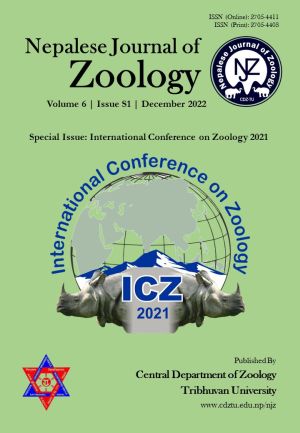Prevalence of gastrointestinal parasites in bovines along the elevation gradients of Annapurna Landscape, Nepal
DOI:
https://doi.org/10.3126/njz.v6iS1.50527Keywords:
Elevation gradient; GI parasites; Livestock; Oocysts; Protozoan parasitesAbstract
Gastrointestinal (GI) parasitic infection is a great concern for livestock management in Nepal, which may vary with the age and sex of the animals, feeding practices, habitat types, and interaction with other domestic and wild animals. As a consequence of growing environmental changes, it is anticipated that temperature and precipitation variation in altitudinal gradients will influence parasite communities and their hosts with unpredictable impacts. In light of this, the current study aimed to explore the pattern of prevalence and factors affecting GI parasites in bovines along the altitudinal and environmental gradients of Chitwan Annapurna Landscape. A total of 600 faecal specimens of bovines were collected from six different blocks and examined microscopically in the Zoology laboratory of Birendra Multiple Campus, Bharatpur, Nepal in between 2019 to 2020. The presence of cysts, oocysts and eggs of parasites in faecal samples were detected morphometrically using standard qualitative and quantitative methods. Out of 600 faecal samples of cattle and buffaloes examined, 64.8% were found positive for one or more species of GI parasites. The prevalence of parasitic infection was significantly higher in cattle (68.8%) as compared to the buffaloes (62.7%, p=0.007). A total of 16 species (5 protozoans, 11 helminths) were reported. The prevalence of GI parasites was significantly lower with increasing annual rainfall, elevation, distance from the forest and water resources (p=0.0001) but significantly higher with increasing temperature (p=0.001). The calf (p=0.028) and sub-adults (p=0.028) were significantly infected than the adults. Despite the fact that a large number of the herders used veterinary drugs for deworming, GI parasites were still rampant in the cows and buffaloes. We conclude that GI parasites are serious problems in the cattle and buffaloes of Chitwan Annapurna Landscape. Hence, regular health checkups, deworming, cleanliness of the sheds, and water resources are suggested regularly.
Downloads
Downloads
Published
How to Cite
Issue
Section
License
Copyright (c) 2022 Dina Nath Dhakal, Jagan Nath Adhikari , Ramesh Sharma Regmi, Sanjib Adhikari, Bishnu Prasad Bhattarai

This work is licensed under a Creative Commons Attribution-NonCommercial 4.0 International License.
This license enables reusers to distribute, remix, adapt, and build upon the material in any medium or format for noncommercial purposes only, and only so long as attribution is given to the creator.

